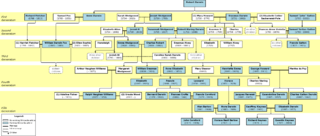
Samuel Dickenson (1733 – May 15, 1823) was an English clergyman and botanist.
He was educated at St John's College, Cambridge, [1] where he was a contemporary of Erasmus Darwin. He succeeded his father John Dickenson as Rector of St. Mary's, Blymhill and remained in the position from 9 January 1777 until his death, aged 90, in 1823.

St John's College is a constituent college of the University of Cambridge. The college was founded by Lady Margaret Beaufort. In constitutional terms, the college is a charitable corporation established by a charter dated 9 April 1511. The aims of the college, as specified by its Statutes, are the promotion of education, religion, learning and research.

The University of Cambridge is a collegiate public research university in Cambridge, United Kingdom. Founded in 1209 and granted a Royal Charter by King Henry III in 1231, Cambridge is the second-oldest university in the English-speaking world and the world's fourth-oldest surviving university. The university grew out of an association of scholars who left the University of Oxford after a dispute with the townspeople. The two 'ancient universities' share many common features and are often referred to jointly as 'Oxbridge'. The history and influence of the University of Cambridge has made it one of the most prestigious universities in the world.

Erasmus Darwin was an English physician. One of the key thinkers of the Midlands Enlightenment, he was also a natural philosopher, physiologist, slave-trade abolitionist, inventor and poet.
Dickenson contributed to various botanical and historical works [2] [3] [4] [5] and was tutor to Thomas Beddoes and Charles Darwin (uncle of the famous naturalist Charles Robert Darwin). He accompanied the 8 year old Darwin on an excursion to France, collecting plants, between October 1766 and March 1767. [6] [7]

Thomas Beddoes was an English physician and scientific writer. He was born in Shifnal, Shropshire. He was a reforming practitioner and teacher of medicine, and an associate of leading scientific figures. He worked to treat tuberculosis.

Charles Robert Darwin, was an English naturalist, geologist and biologist, best known for his contributions to the science of evolution. His proposition that all species of life have descended over time from common ancestors is now widely accepted, and considered a foundational concept in science. In a joint publication with Alfred Russel Wallace, he introduced his scientific theory that this branching pattern of evolution resulted from a process that he called natural selection, in which the struggle for existence has a similar effect to the artificial selection involved in selective breeding.
The inscription on his memorial in St. Mary's reads:
Revd. Samuel Dickenson during 46 years Rector of this place his character was adorned with many virtues, his mind richly stored with learning divine and humane, he was remarkably upright in his dealings & strictly temperate in his mode of living, in simplicity & godly sincerity. He had his conversation in the world. [8]












